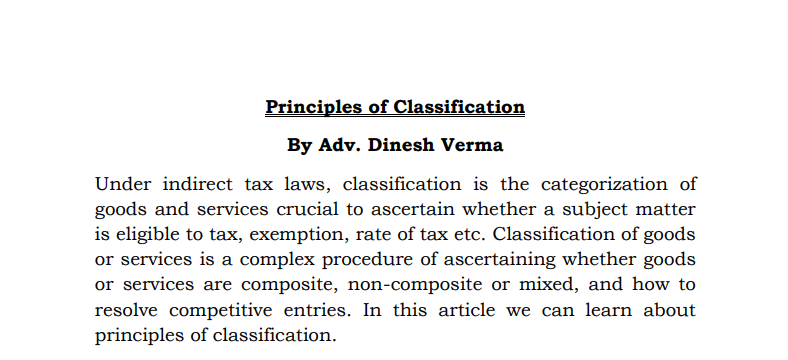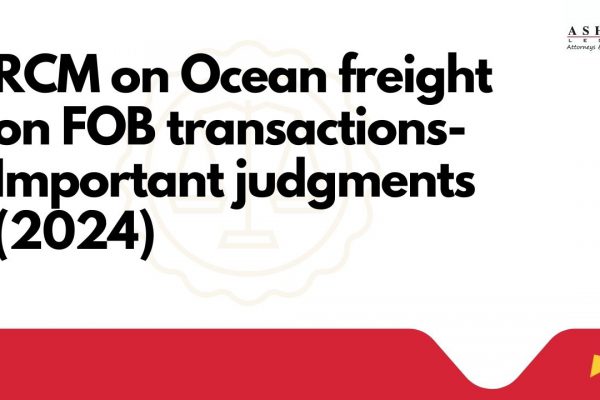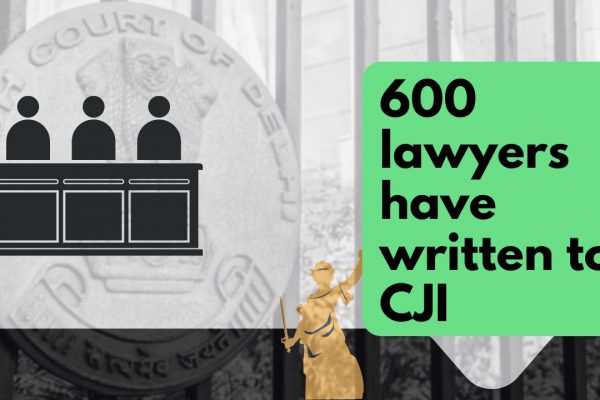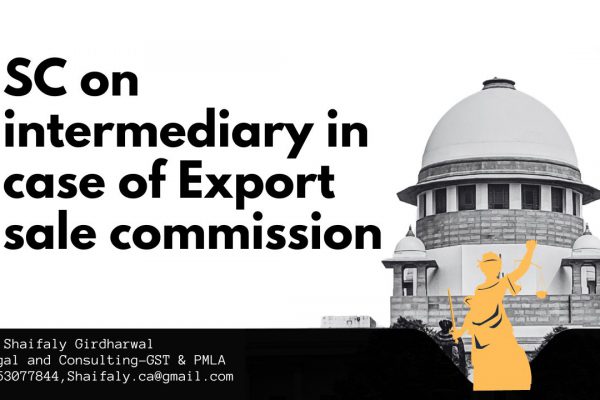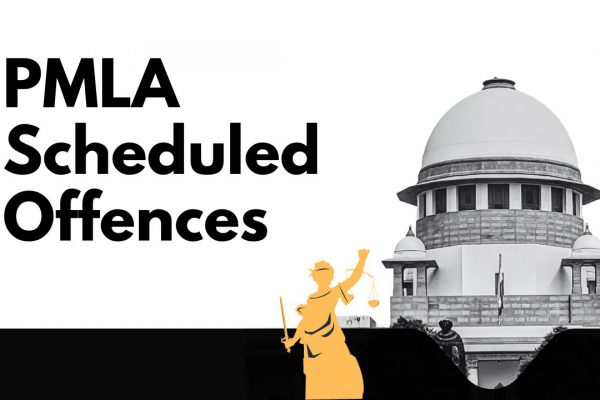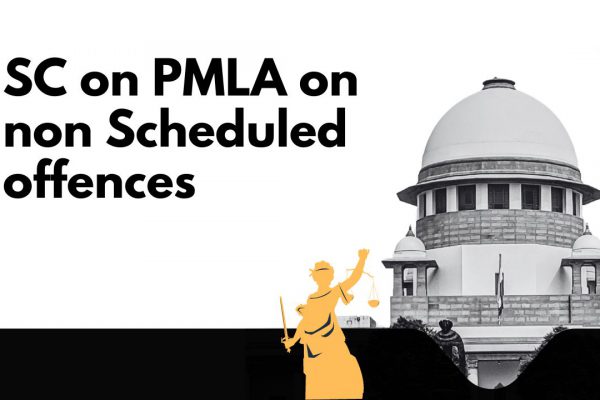Principles of Classification
Principles of Classification
Under indirect tax laws, classification is the categorization of goods and services crucial to ascertain whether a subject matter is eligible to tax, exemption, rate of tax, etc. Classification of goods or services is a complex procedure of ascertaining whether goods or services are composite, non-composite or mixed, and how to resolve competitive entries. In this article, we can learn about the principles of classification.
1. Introduction
The term classification implies arrangement according to classes or types. The scheme of indirect taxation requires the classification of goods/services under the various headings provided under these laws to determine whether or not the same would be encumbered by the levy of these taxes and if so, under which heading the duty liability would accrue.
In the case of GST legislations, similar to other indirect tax laws, classification is given a detailed enunciation within the legislative framework. There are elaborate statutorily stipulated rules to determine whether the supply concerned is a supply of “goods” or “services” and thereafter classify such goods or services within the rate schedule (also known as “tariff”) to ascertain their taxability and, if so, the applicable rate of tax on such supply.
2. Goods
Section 2(22) of Customs Act, 1962 defines as under:
“Goods” include includes-
(a) Vessels, aircraft and vehicles;
(b) Stores;
(c) Currency and negotiable instruments; and
(d) Any other kind of movable property;
Or
Section 2(52), of GST Act, states that “goods means every kind of movable property other than money and securities but includes actionable claim, growing crops, grass, and things attached to or forming part of the land which are agreed to be severed before supply or under a contract of supply”.
Or
Article 366 (12) of the Indian Constitution defines goods as “Goods includes all materials, commodities, and articles.”
3. Sales tax and VAT
The imposition of tax on the sale of goods is essentially in the nature of a trade tax, being an indirect tax. The levy is upon the incidence of sale of goods. For the purpose of the imposition of the levy, the various goods have been segregated into various headings.
The above levy comprises two limbs, i.e. Central Sales Tax and State Sales Tax. Central Sales Tax is levied upon sales spanning between two states or interstate sales while state sales tax encumbers sales effected within the state. The legislation regarding State sales tax received a makeover when the VAT Acts were introduced replacing the old State Sales Tax Acts.
Related Topic:
Principles for Determining Supply of Goods/Services in the Course of Interstate Trade or Commerce
4. Central Excise and Customs
Section 37B of the Central Excise Act, 1944 empowers the central board of excise and customs to issue orders, instructions and directions, for the purpose of uniformity in the classification of goods or with respect to the levy of excise duties on such goods.
Central excise tariff is based on the Harmonized System of Nomenclature (HSN). When there is no ambiguity about the scope of the entry, the classification is to be done as per the entry in the tariff itself. HSN explanatory notes can be resorted to in the case of ambiguity in classifying goods.
It is pertinent to that both the central excise and customs tariffs contain general principles for the interpretation of the tariff. The said rules are:
Rule 1 states that the titles of sections, chapters, and subchapters are provided for ease of reference and determination of where the goods fall will be dependent on the relevant section and chapter notes contained in the tariff. Therefore, headings are not determinative of classification.
Rule 2(a) States that an article referred to in the schedule would be said to include the same when it is incomplete or unfinished if it has the essential character of the complete or unfinished article. It would include therefore articles presented in unassembled form.
Rule 2(b) States that a heading referring to a material or substance shall be taken to include a reference to mixtures or combinations of that material or substance with other materials or substances.
Rule 3 provides for circumstances where the goods seem to be classifiable under more than one heading and provides as follows:
(a) The heading which provides the most specific description shall be preferred to headings providing a more general description. However, when two or more headings each refer to part only of the materials or substances contained in mixed or composite goods or to part only of the items in a set put up for a retail sale, those headings are to be regarded as equally specific in relation to those goods, even if one of them gives a more complete or precise description of the goods.
(b) Mixtures, composite goods consisting of different materials or made up of different components, and goods put up in sets for retail sale, which cannot be classified by reference to (a), shall be classified as if they consisted of the material or component which gives them their essential character, insofar as this criterion is applicable.
(c) When goods cannot be classified by reference to (a) or (b), they shall be classified under the heading which occurs last in numerical order among those which equally merit consideration.
In Akbar Badruddin Jaiwani vs. CC 1990 (47) ELT 161 (SC), the supreme court was faced with the question of whether marble was a polishable calcareous stone. While holding that the slabs of calcareous stone imported by the appellant were not marbled as mentioned in entry no. 62 of Appendix 2 of the Import and Export policy for April 1988-March 1991 and so was covered by open general license, it was also held that the express wording of the Tariff Headings and relevant Section and chapter notes would take precedence over the commercial or trade parlance test for classifying excisable goods. However if the specific headings and notes do not cover the excisable goods, then the resort must be had to the commercial or trade understanding of the goods.
In the case of CCE, Bhubaneswar vs. Champdany Industries ltd. 2009 (241) ELT 481 (SC), the supreme court, while holding that multi-fabric carpets in which jute was the predominant material used were classifiable as jute carpets, stated that the dominant intention of the rules was to classify goods under the heading which provided most specific description than the one providing a general description. The interpretative rules were held to be inapplicable when the section and chapter notes provided clarity on classification.
5. Common/Commercial Parlance
As stated earlier, the common parlance test is used in the absence of any statutory guidelines.
The high court of Bombay in the case of CST vs. Dev Enterprises ltd. (2011) 42 VST 504 (Bom) while holding that footwear was classifiable under residual Entry E-1 and liable to tax at 12.5%, noted the decision in A. Nagaraju Bros vs. State of Andhra Pradesh (1994) 95 STC 1 (SC) as follows:
“The Supreme Court noted that there was no single or universal test to be applied and it is for this reason probably that the common parlance test or commercial usage test is treated as a more appropriate test, though, not the only one. The court held that there may be cases, particularly in the case of new products, where this test may not be appropriate, in such cases, other tests like the test of predominance, either by weight or value or on some other basis may have to be applied.
6. Dictionary Meaning
In the case of Collector of Central Excise, Kanpur vs. Krishna Carbon Paper Co. 1988 (37) ELT 480 (SC) while answering the questions whether carbon papers could be included in “all kinds of paper including the paper which have been subjected to coating” during the relevant period in the affirmative, the Supreme court observed that:
“It is well-settled that in order to ascertain the correct meaning of a fiscal entry reference to a dictionary is apt to be a somewhat delusive guide, as it gives all the different shades of meaning”.
The Supreme Court observed that reference to a dictionary meaning is not safe when there is no definition in the statue for ascertaining the meaning of tariff entry. The correct guide would be parlance. Where either of the two is not possible then the meaning following from the statue at a particular point of time would be a decisive test. In other cases where no evidence is available other than the ISI specifications, these should be relied upon for interpreting a Tariff entry.
7. Expert Opinion
In the case of CCE vs. J.L. Morison 1986 (25) ELT 660 (Kar), the question was whether the local anesthetic manufactured by the Respondent without using alcohol falls within item 1(iii) of the Schedule to the medicinal and Toilet preparations (Excise Duties) Act, 1955 or under item 14E of the Central Excise Tariff and, therefore, stood excluded from item 1(iii) of the Act. It was observed that classifications of goods involving technical questions are not decide-able without technical options.
8. End-Use
In Indian Aluminium Cables ltd. vs. UOI (21) ELT 3 (SC) it was held that process of manufacture and end-use to which it is put, cannot necessarily be determinative of classification of that product under a fiscal statute like CETA. What is more important is whether the broad description of the article fits in the expression used in the tariff.
Therefore, it appears that predominantly, the end-user test would not be used as a first principle and would come in last if there is no other test or the tariff entry itself is based on end-use.
9. HSN & ISI Technology
The Supreme Court was held in CCE vs. Wood Craft Products Ltd. 1995 (77) ELT 23 (SC), while holding that blocks boards were classifiable under heading 44.08 under the expression similar lamented wood, observed that HSN can be resorted to in case of ambiguity in classifying goods. The use of HSN must be preferred over the ISI terminology.
Therefore, the principle is that HSN would apply where the tariff is aligned along with HSN, otherwise, the entries have to be interpreted on their own strength.
10. The search of HSN Code
Chapter note of Tariff Heading is specified in GST Tariff ACT. For the purpose of classification an example of Textile & Textile Article (Section XI) wide Chapter Note 2 are reproduced below:
A) Goods classifiable in chapters 50 to 55 or in heading 5809 or 5902 and of a mixture of two or more textile materials are to be classified as if consisting wholly of that one textile material which predominates by weight over any other single textile material.
Read & Download the full copy in pdf:
If you already have a premium membership, Sign In.
 Advocate Dinesh Verma
Advocate Dinesh Verma


